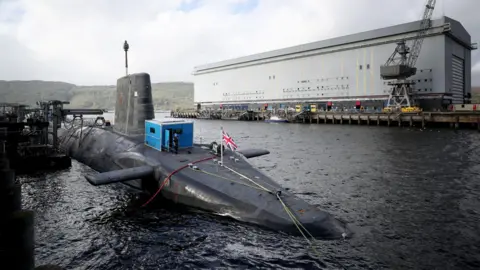Scotland to get extra £2.9bn from spending review, says Treasury
 North Sea Midstream Partners
North Sea Midstream PartnersHolyrood's budget will rise by £2.9bn a year on average as a result of Chancellor Rachel Reeves' spending review, according to Treasury officials.
Reeves said block grant funding from Westminster would rise to £52bn by 2029, the "largest settlement in real terms since devolution was introduced".
Setting out the UK's first multi-year spending review since 2021, she also confirmed investment in defence, carbon capture and computing projects.
But Scotland's Finance Secretary Shona Robison claimed her government had been "short changed" by more than £1bn, with a block grant increase which is smaller than the overall rise across UK government departments.
The chancellor's spending review confirmed funding for a number of specific projects in Scotland, some of which had been trailed ahead of her speech.
They include development funding for the Acorn Project carbon capture scheme in Aberdeenshire, though the exact amount was not revealed.
A supercomputer project at Edinburgh University will get £750m and £250m has been allocated to develop facilities at the Faslane nuclear submarine base.
Increased funding for the NHS and housing in the rest of the UK will also have a knock-on effect on the money the Scottish government receives annually from Westminster, which is calculated using the Barnett Formula.
The Scotland Office said the Scottish government would receive an extra £9.1bn across the duration of the spending review.
However, Scotland's finance secretary said there should have been a bigger increase in day-to-day funding.
Shona Robison said: "Today's settlement for Scotland is particularly disappointing, with real terms growth of 0.8% a year for our overall block grant, which is lower than the average for UK departments.
"Had our resource funding for day-to-day priorities grown in line with the UK government's overall spending, we would have £1.1bn more to spend on our priorities over the next three years.
"In effect, Scotland has been short-changed by more than a billion pounds."
What changes will there be for defence spending?
Reeves said overall UK defence spending would rise to 2.6% by April 2027 as part of a plan to make Britain a "defence industrial superpower".
This includes a promise to spend "an initial £250m" over three years on the Faslane submarine base, "supporting jobs, skills and growth across the west of Scotland".
Details of what the investment will involve have still to be released but Defence Secretary John Healey said it would provide "long-term, sustained investment for HMNB Clyde" to keep submarines maintained and operational around the clock.
The chancellor also announced £4.5bn would be invested in munitions at several sites across the UK, including Glasgow.
 PA Media
PA MediaDevelopment funding to advance a carbon capture project in Aberdeenshire was also announced in the spending review.
The Acorn Project based in St Fergus would take greenhouse gas emissions and store them under the North Sea, in a process known as carbon capture and storage (CCS).
It comes following calls from business leaders for investment in the long-delayed project, which had previously been on a reserve list for funding.
The exact amount of development funding for the project has not been announced.
Documents said "a final investment decision will be taken later this parliament, subject to project readiness and affordability".
What is the Edinburgh super-computer project?
 University of Edinburgh
University of EdinburghThe review also plans for the building of the most powerful supercomputer in the UK at the University of Edinburgh.
The chancellor pledged up to £750m for the scheme, which will give scientists from across the UK the computing power needed for research on projects such as modelling climate change or developing new medicines.
Funding for the supercomputer was dropped when Labour took power after last year's general election but has now been reinstated.
The new supercomputer will vastly exceed the capacity of the UK's current national supercomputer, Archer2, which is also housed at the university.
Prof Sir Peter Mathieson, principal and vice-chancellor of the University of Edinburgh, said "This significant investment will have a profoundly positive impact on the UK's global standing, and we welcome the vast opportunities it will create for research and innovation."
The university has already spent £31m on the infrastructure required to house the new supercomputer.

Puzzled by these big numbers? You're not alone. Let's try to break down the ones that matter most.
The chancellor talked in her speech about a £52bn Holyrood budget after three years of rises.
That is not the result of this Spending Review, but the total amount reached after many years. It doesn't include the effect of reducing the block grant, by the amount that would have been raised if some taxes had not been devolved to Holyrood.
That reduced block grant then has such revenues added, the biggest of them Scottish income tax.
So £52bn probably won't help explain the Spending Review, but it looks an impressively big figure.
Shona Robison's response to the Spending Review is that there's a gap of £1bn arising from the level of average increase in day-to-day spending across Whitehall departments and the amount being added to the Treasury's block grant allocated to Holyrood.
That may reflect increases in spending in departments that are reserved, including defence, which is one of the bigger winners from this review.
It seems there will be a lot more money by-passing Holyrood for direct spending in Scotland by Whitehall departments than used to be the case.
For instance, where there is money allocated to the tax breaks to be found for businesses setting up in green freeports in Scotland - the ones in the Firth of Forth and the Cromarty Firth - that funding by-passes Holyrood.
Likewise the supercomputer for Edinburgh University and the £250m for upgrading the Faslane submarine base.
The numbers that might be useful to understanding the scale of increase or of challenge for Holyrood's budgets are:
- an average 0.8% real terms increase in day-to-day (or current) budget in the block grant, over three years, and
- a 0.3% increase in the capital budget, averaged over the next four years.
That's against an average increase of 1.5% for day-to-day spending across Rachel Reeves' review of the next three years, and 1.8% for capital.
Behind her figures is a big expectation of more efficiency from government spending, hitting hardest in HM Revenue and Customs and the Department of Transport.
Use of technology, better management of civil servants and more efficient use of buildings and land are among the methods being urged on Whitehall, with pressure on Shona Robison to do likewise in Scotland.
The finance secretary's medium term financial strategy - a fancy name for looking five years ahead - was postponed until after the Downing Street Spending Review, and later this month, it should set out some of the Scottish Government thinking.
But we'll have to wait until much later this year to see the Scottish government's version of the Spending Review, a few months before the next Holyrood election.
